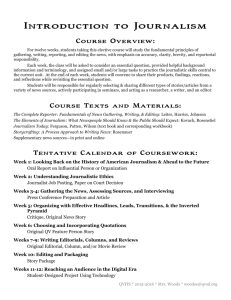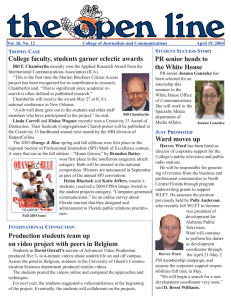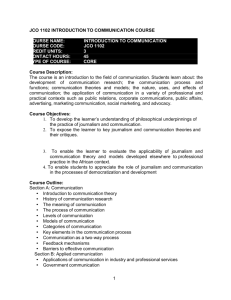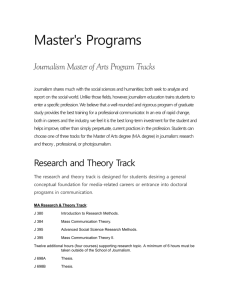JCO 2103 NEWS REPORTING ANDWRITING I
advertisement
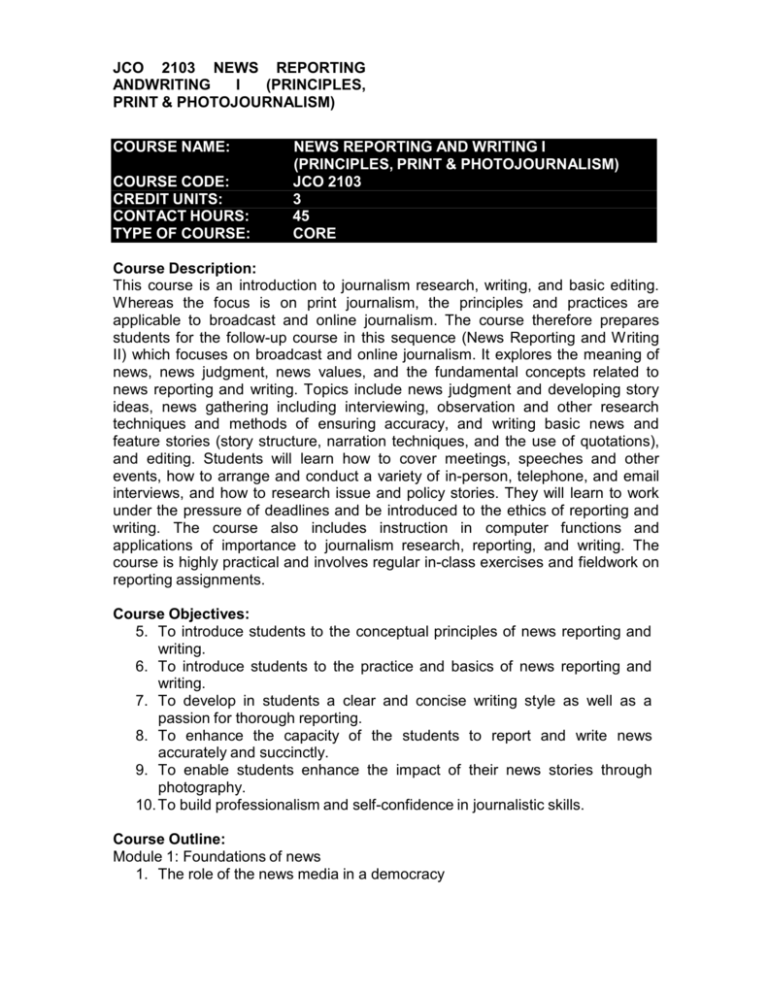
JCO 2103 NEWS REPORTING ANDWRITING I (PRINCIPLES, PRINT & PHOTOJOURNALISM) COURSE NAME: COURSE CODE: CREDIT UNITS: CONTACT HOURS: TYPE OF COURSE: NEWS REPORTING AND WRITING I (PRINCIPLES, PRINT & PHOTOJOURNALISM) JCO 2103 3 45 CORE Course Description: This course is an introduction to journalism research, writing, and basic editing. Whereas the focus is on print journalism, the principles and practices are applicable to broadcast and online journalism. The course therefore prepares students for the follow-up course in this sequence (News Reporting and Writing II) which focuses on broadcast and online journalism. It explores the meaning of news, news judgment, news values, and the fundamental concepts related to news reporting and writing. Topics include news judgment and developing story ideas, news gathering including interviewing, observation and other research techniques and methods of ensuring accuracy, and writing basic news and feature stories (story structure, narration techniques, and the use of quotations), and editing. Students will learn how to cover meetings, speeches and other events, how to arrange and conduct a variety of in-person, telephone, and email interviews, and how to research issue and policy stories. They will learn to work under the pressure of deadlines and be introduced to the ethics of reporting and writing. The course also includes instruction in computer functions and applications of importance to journalism research, reporting, and writing. The course is highly practical and involves regular in-class exercises and fieldwork on reporting assignments. Course Objectives: 5. To introduce students to the conceptual principles of news reporting and writing. 6. To introduce students to the practice and basics of news reporting and writing. 7. To develop in students a clear and concise writing style as well as a passion for thorough reporting. 8. To enhance the capacity of the students to report and write news accurately and succinctly. 9. To enable students enhance the impact of their news stories through photography. 10. To build professionalism and self-confidence in journalistic skills. Course Outline: Module 1: Foundations of news 1. The role of the news media in a democracy 2. The importance of trained, committed journalists to serve as the bridge between government and citizens 3. What news is and its importance to society 4. Organization and structure of the modern newsroom 5. News values Module 2: News reporting, writing, and editing for publication 1. The principles of news reporting and writing 2. Reporting and writing strategies 3. Writing strategies and storytelling techniques 4. Anatomy of a feature story 5. Contrasting news and feature formats and styles 6. Editing for different news and feature formats and styles 7. Digging for information and initiating newsgathering 8. Building and using background information and finding sources 9. Covering the community on a day-to-day basis 10. Legal and ethical considerations 11. Taste – defining what is appropriate 12. The morality of journalism 13. In-depth and investigative reporting 14. Computer-assisted reporting and research Module 3: Photojournalism 1. Principles and practices of photojournalism 2. Techniques of news photography 3. Photographing features, portraits, and sports Learning Outcomes: By the end of the course, the students should be able: 1. To experience the real world of journalism where they will report and write on deadline and under organizational, editorial, and societal pressures. 2. To go beyond the basic news values and merely chronicling events as they happen to providing context and giving perspective. 3. To demonstrate an understanding of today’s news industry and processes. 4. To remain objective while interpreting issues and events and locating them in wider perspectives. 5. To combine text and photos to produce stories for publication. 6. To act as their own editors. Methods of Teaching/Delivery: • Interactive lecture • Brainstorming • Group work • Library research • Fieldwork Methods of Assessment: • Progressive assessment 100% Readings/Reference Materials/Learning Resources: • Fox, W. (2001). Writing the News: A Guide for Print Journalists, 3rd ed. • Dedman, B. Power Reporting, http://www.powerreporting.com. Resources and training in computer-assisted reporting and editing. • Friendlander, E.J. & Lee, J. (2000). Feature Writing for Newspapers and Magazines, 4th ed. • Mencher, M. (2006). News Reporting and Writing, 10th ed. • Quinn, S. (2005). Convergent Journalism: The Fundamentals of Multimedia Reporting. New York: Peter Lang Publishing. • Rich, C. (2007). Writing and Reporting News, 5th ed.
